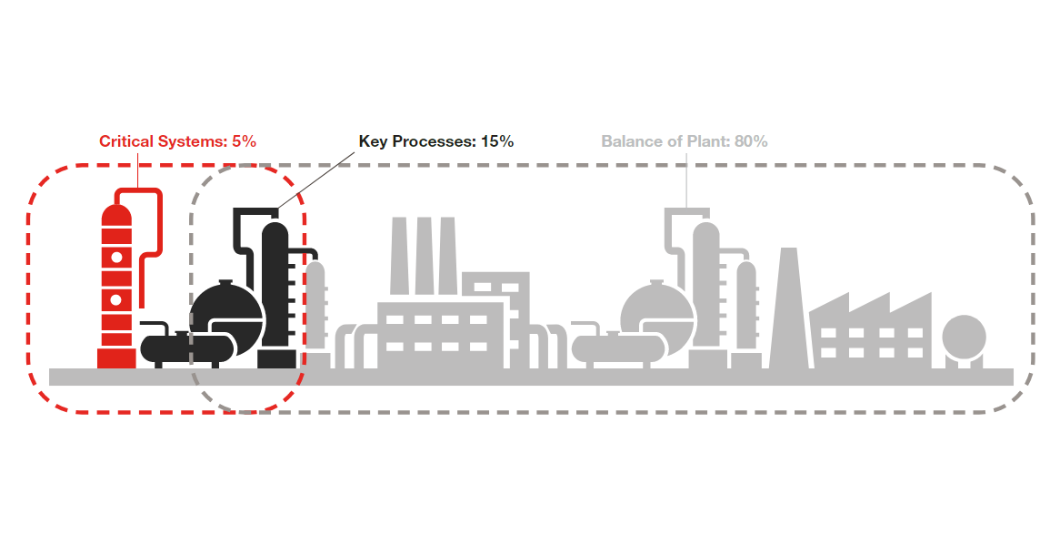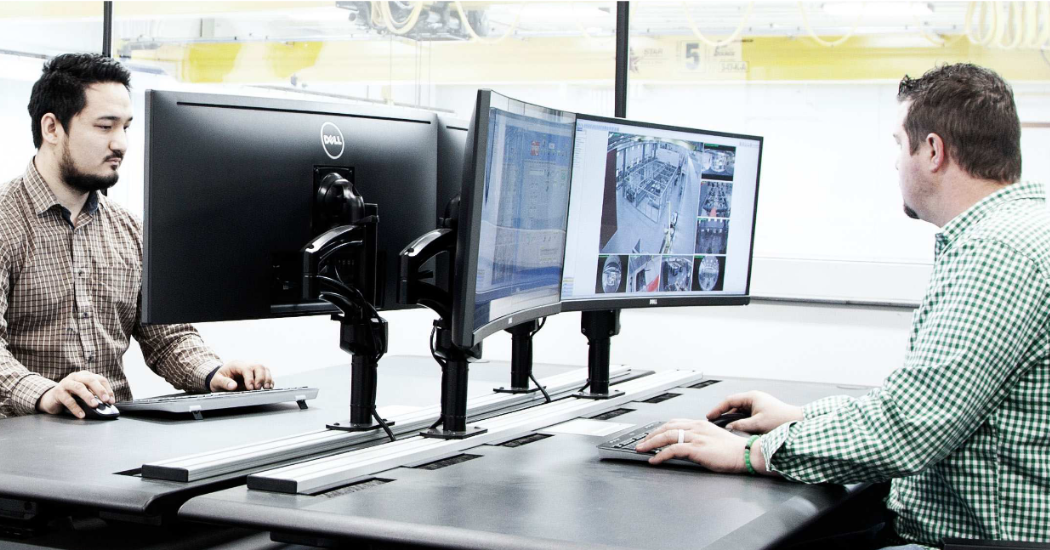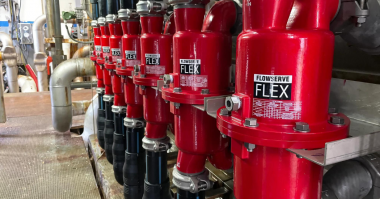There’s a lot of talk about how equipment monitoring and predictive analytics can revolutionize the fluid motion industry. Hundreds of thousands of words have been written about these technologies, and it’s safe to say that many of these words deliver broad, ill-defined platitudes and promises. Flowserve thinks it’s important to break through the noise to explain what you can realistically achieve.
 Breaking down the benefits
Breaking down the benefits
With equipment monitoring, plant reliability engineers, operators and maintenance personnel predict equipment and system behaviors and take prompt actions when necessary to prevent unplanned downtime. This can result in a variety of benefits, namely:
Prevent expensive repairs and maintenance delays. Companies can reduce equipment lifecycle costs by minimizing unscheduled downtime, lowering maintenance costs, and preventing expensive repairs and maintenance delays.
Only inspect equipment that requires attention. Companies can optimize the performance of their assets by improving equipment productivity, only inspecting those that require attention, and keeping fewer spare parts in inventory.
Detect and address unacceptable operating conditions. Companies can improve reliability and availability by detecting and addressing unacceptable operating conditions before they evolve into significant issues.
Know how equipment is performing and how to optimize it for maximum efficiency. As equipment performance deteriorates, its energy demand increases and its time to failure or repair can drop dramatically. With equipment monitoring and predicting, companies can know where their equipment is performing on the operating curve — and how to optimize it for maximum efficiency.
Reduce the time employees spend in higher-risk areas. Companies can reduce the time their employees spend in higher-risk areas by knowing exactly where the problem is and what it will take to fix it.
Breaking through the benefits to get results
Achieving these benefits requires a three-step approach that includes:
1. Deciding what equipment to monitor and what data you want to collect
2. Selecting hardware, software and algorithms to predict events
3. Partnering with a service company to address adverse equipment conditions
Let’s take a closer look at each of these areas to examine their respective role in the process.
 Step 1: Monitoring primary (or critical) vs. balance-of-plant (non-critical) equipment
Step 1: Monitoring primary (or critical) vs. balance-of-plant (non-critical) equipment
Predictive analytics for critical equipment —Both condition monitoring and predictive analytics will
provide important operating data, but predictive analytics provides deeper insight, which is why it’s used on primary equipment where failure and downtime can significantly impact productivity and revenue. This method would be similar to visiting a specialist or having an MRI done to get a more detailed diagnosis. Predictive analytics also requires sensors to capture and transmit operational data.
By capturing more information, reliability engineers have more data to work with, which is essential for full-spectrum analysis and when applying algorithms (more on this in step 2). It’s important to understand what data your sensors collect, regardless if you’re collecting snapshot information or continuous, full-spectrum data; the amount and type of data collected will determine how much you can learn about your equipment.
Condition monitoring for balance-of-plant (non-critical) equipment —Condition monitoring provides a more basic snapshot of equipment performance and is typically reserved for balance-of-plant equipment. This would be similar to a doctor taking your blood pressure and temperature in his/her office. The service requires sensors (sometimes hundreds across a plant) to capture equipment performance data and transmit this data to a central hub for trend analysis. Sensors are used to collect information such as vibration, temperature and pressure. Using this data, reliability engineers can receive alerts and generate trend reports to observe how equipment performs over time. Once they identify any anomalies, maintenance teams can order parts and repair the equipment, preventing downtime and lost productivity.
Step 2: Understand how software and algorithms uncover potential problems
One of the significant benefits of predictive analytics is its ability to compare performance data to algorithms to identify signs of equipment failure. Algorithms analyze equipment performance data, look for specific indicators, and make predictions on what is likely to happen in the future. It’s important to understand that algorithms are based on proprietary models, methodologies and industry experience, so the company providing the algorithms has a significant impact on what an operation can achieve by using them. Algorithms can diagnose a variety of failure modes and conditions, including:
- Imbalance
- Misalignment pump and motor
- Unacceptable pipeline forces
- Insufficient NPSHA/cavitation
- Liquid turbulences
- Low load or overload
- Vane passing frequency
- Dry running indirectly
- Mechanical friction of rotating parts
- Bearing wear
- Magnetic coupling disengagement/slippage
- Pin coupling wear
- Loose mechanical parts
- Resonance frequency
- Q-H performance curves and degradation
- Online measured clearances for wear parts
- Remaining time to maintenance for wear parts and impellers
- Recirculation
- Blockage of balance line
- Cracked or broken shafts
- Run-out or bent rotors
- Excessive axial thrust
 Did you know?
Did you know?
Flowserve software is easy to use with existing infrastructure (Flowserve and non-Flowserve equipment), ready to work on any platform, from the plant control room, a maintenance technician’s handheld, an engineer’s laptop or in the cloud.
 Step 3: Establish service and repair expertise
Step 3: Establish service and repair expertise
The ability to repair equipment problems before they result in downtime, lost productivity and revenue is the greatest benefit of equipment monitoring and predictive analytics. However, without access to repair and maintenance expertise, a failing piece of equipment is a ticking time bomb.
Expertise can make the difference
The major players in the space range from large technology companies to digital transformation influencers to vertical specialists, all touting myriad approaches, tools and methodologies.
Before you select a partner, ensure they understand:
- What specific data to collect
- How frequently to collect the data to be effective
- How to align the data with equipment characteristics
- How to factor in repair history and equipment expectations
- How to reliably and securely transmit full-spectrum data wherever it’s needed
- What preventive actions are required to repair a variety of adverse equipment conditions
Advancements in asset health management have created tremendous excitement. Companies that understand what is possible with these new advancements in technologies, as well as the steps required to implement these tools effectively, are more likely to experience the benefits they have to offer.
The Flowserve advantage: Flowserve is different from these other solution providers because our expertise is rooted in rotating equipment design and manufacturing. Now Flowserve is taking the lead in creating new technologies to detect, diagnose and optimize flow-related equipment, giving customers complete solutions that improve the overall performance of their operations.
Offers a range of sensors that continuously collect and/or transmit specified performance data from any rotating equipment (critical or non-critical).
Flowserve software and analytics can diagnose problems in pumps, valves and seals, learn from their lifecycles, predict their future working life, and uniquely prescribe the steps to fix them.
A global network of service centers means we can immediately deploy highly qualified resources to customer facilities, regardless of where they’re located.
Engineers and technicians know this equipment inside and out, and understand what conditions can affect their performance.
Has a complete understanding of data collection, analysis, diagnosis, recommendations and corrective actions.
Leverages specialized engineering intelligence in fluid motion to create algorithms that diagnose precisely when equipment maintenance will be required and how to remedy the situation immediately.
The future of Flowserve
When it comes to manufacturing and servicing flow control equipment, Flowserve has been a leader in the industry for more than 200 years. We now have advanced predictive analytics and condition monitoring technology to help our customers detect and diagnose problems, and all the resources, tools and knowledge it takes to solve them. Contact us to schedule a comprehensive on-site demo to see how our solutions provide a complete view of your equipment’s health and help prevent equipment failures and system disruptions.
About the author
Shashank Khandavalli, MBA
Global Product Leader, IoT
As a graduate of the University of North Carolina, Shashank has spent time learning and mastering the IoT industry. His years of experience and passion for innovation are unmatched. His expertise is leading Flowserve into the future of IoT.





Comments